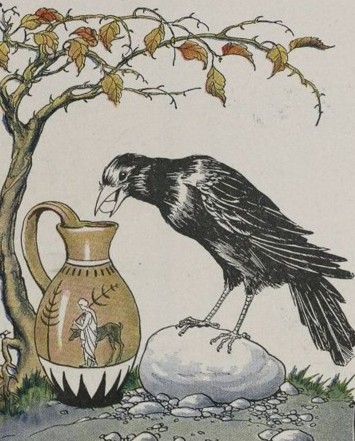Crowing
You probably know the name Aesop, a Greek storyteller who is credited with writing hundreds of fables, many of which use animals to teach people young and old about the world and about ourselves. One of Aesop’s best-known fables, for example, is the Tortoise and the Hare. The slow tortoise and the fast hare race against each other, with the hare the obvious favorite given its inherent advantage in the speed category. But the hare gets cocky, taking breaks when it shouldn’t and ultimately falling asleep, allowing the tortoise enough time to win. The morals of the story: don’t take victory for granted, task persistence pays off, and colloquially, slow and steady wins the race.
Few, if any, object to the fact that actual tortoises and hares aren’t intelligent enough to engage in a coordinated race, let alone speak to one another. Most of Aesop’s fables ignore these problems — they’re fables, after all, and realism is optional. Take, as another example, the story of the Crow and the Pitcher, reprinted below (and depicted above), via the appropriately-named AesopsFables.com:
A Crow, half-dead with thirst, came upon a Pitcher which had once been full of water; but when the Crow put its beak into the mouth of the Pitcher he found that only very little water was left in it, and that he could not reach far enough down to get at it. He tried, and he tried, but at last had to give up in despair. Then a thought came to him, and he took a pebble and dropped it into the Pitcher. Then he took another pebble and dropped it into the Pitcher. Then he took another pebble and dropped that into the Pitcher. Then he took another pebble and dropped that into the Pitcher. Then he took another pebble and dropped that into the Pitcher. Then he took another pebble and dropped that into the Pitcher. At last, at last, he saw the water mount up near him, and after casting in a few more pebbles he was able to quench his thirst and save his life.
The story above models flexible thinking — finding creative solutions and using tools that aren’t obvious for the task at hand. Like the Tortoise and the Hare, it also advocates for task persistence — keep adding pebbles and you’ll get the water. And also like the Tortoise and the Hare, it’s a fanciful, impossible story; there’s simply no way a crow could do what’s described.
Oh, wait: yes they can.
Whether Aesop (or whoever penned the fable attributed to him) knew that crows could actually do this is unknown, but it’s likely he did. Pliny the Elder apparently observed something like this about 2,000 years ago, and while that leaves a roughly 500-year gap unaccounted for, the coincidence seems incredibly unlikely. Either way, perhaps there’s another lesson to be learned from the fable of the Crow and the Pitcher: don’t underestimate the intelligence of others. They just might surprise you.
Bonus Fact: This isn’t the only example of crows using tools and generally being smart, either. As seen in this video, some crows have found an ingenious way to crack open nuts, without the use of a nutcracker or opposable thumbs (which they obviously lack). The crows take the nuts above a traffic intersection and drop the potential food to the ground below, aiming for the crosswalk. Then they wait for a car or truck to smash the shell open, revealing the treat inside. Finally, the crows wait for the light to change, allowing pedestrians to enter the crosswalk. The crow joins them, picking up the shelled nut in its beak and flying away before traffic resumes through the intersection.
From the Archives: Window Pains: Birds and glass don’t mix.

